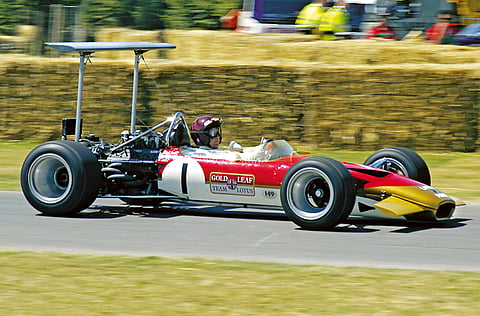Lotus 49
The Lotus 49 is legendary for all the right reasons

Colin Chapman broke new ground in most engineering aspects of a Formula 1 car, whether it was rear suspension struts, monocoque chassis, aerodynamic wings, side-mounted radiators (to free up the front and reduce frontal area, decreasing drag — in other words, more speed), or mad experiments like twin-chassis, ground effect and vacuum-creating side skirts for absurd grip.
The famed Lotus designer, however, didn’t just leave his mark on the engineering
side of things, having also changed the commercial world of Formula 1, diverting its path from a gentlemen’s pastime into a multi-billion dollar industry.
The car that helped do all that was Chapman’s Lotus 49. Created together with his aircraft-specialist buddy Maurice Philippe, the low-flying Lotus 49 Grand Prix car was in more ways than one influenced by slightly higher flying stuff such as Comet and De Havilland planes.
The 49 was the first F1 car to feature aerofoil wings mounted directly to the suspension, before settling into their now common position of being integrated into the bodywork. More significantly, the 49 was the first F1 car to be designed around an engine, the legendary Cosworth DFV, in part commissioned by Chapman, as it featured the V8 as a structural member of the car bolted directly to the aluminium monocoque tub, and solely supporting the transmission and rear suspension components.
Today all F1 cars, and indeed the vast majority of open-wheeler single-seaters and prototype racers, are designed in this way. But for all its design advancements that gave the 49 a storied racing life some four Grand Prix seasons long — the car won on its debut at the Dutch Zandvoort circuit with Jim Clark behind the wheel and took two championships — it was the commercial doing that left its mark on Formula 1.
Colin Chapman scored a coup when he stuck cigarette brand John Player Gold’s colours all over a Lotus 49 and put Clark in the car for the off-season non-championship event at New Zealand’s Pukekohe circuit in 1968. It was the beginning of big-money racing and the love affair between Formula 1 and tobacco advertising lasted all the way until 2007.
Even today a Lotus 49 is instantly recognisable thanks to its white, gold and red John Player Gold livery, and team colours in Formula 1 soon took a back door to the corporate liveries of tobacco brands such as Marlboro, Gitanes, Camel, John Player Special, Lucky Strike, Rothmans, Winston, West, Benson & Hedges, Mild Seven…
Sign up for the Daily Briefing
Get the latest news and updates straight to your inbox


